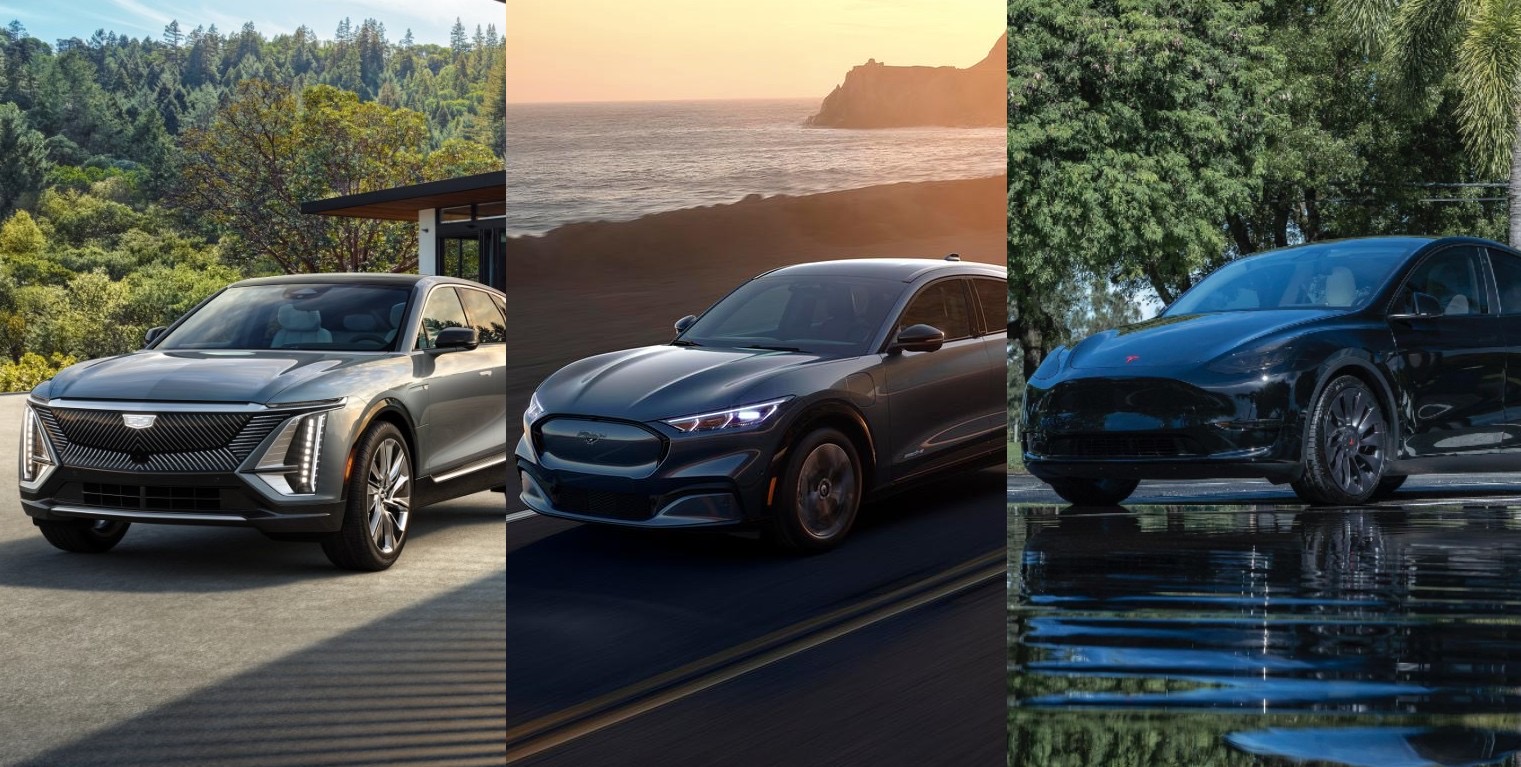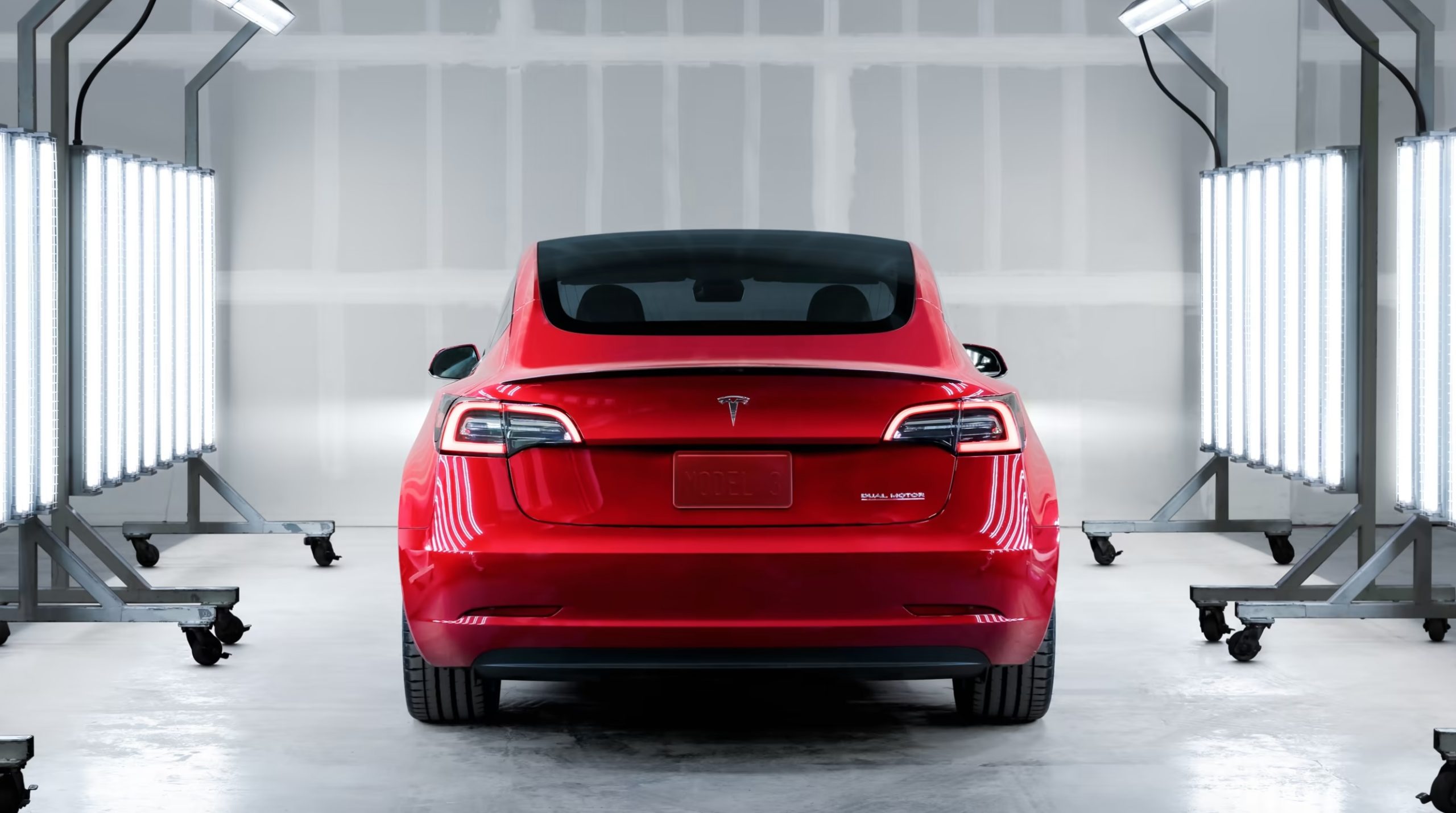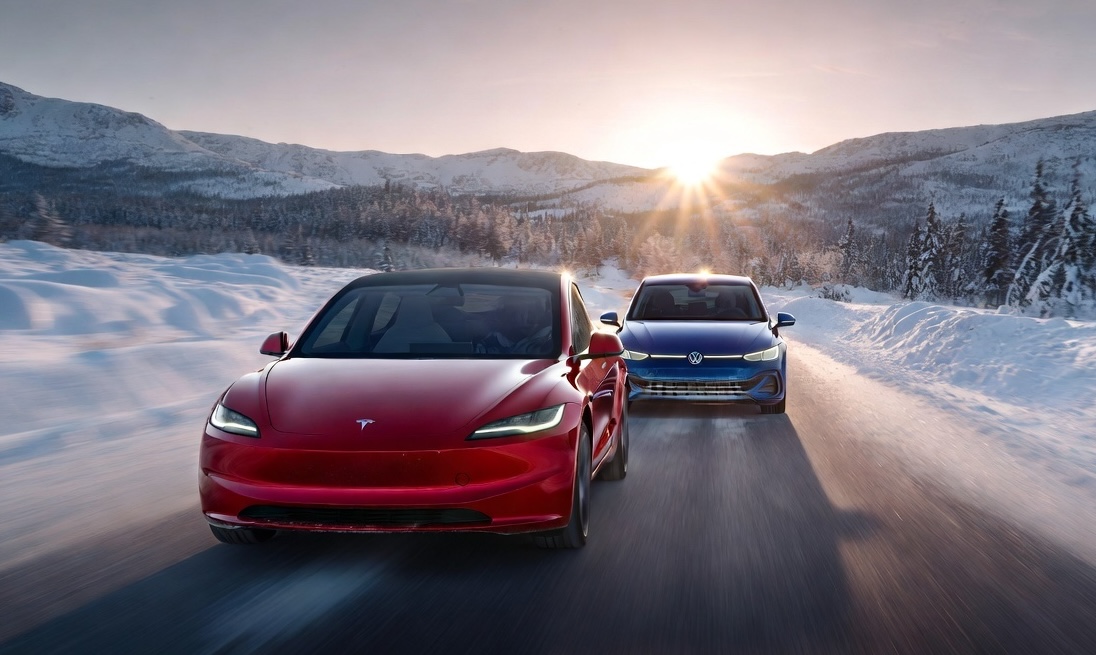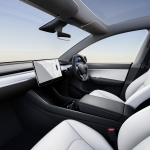

News
Cadillac Lyriq vs Ford Mach-E vs Tesla Model Y: Features, price, and tech comparison
GM has entered the premium all-electric crossover SUV market, and its flagship vehicle is the rather eye-catching Cadillac Lyriq. Poised to hit the roads in the first half of 2022, the Lyriq will be entering an market already saturated by formidable opponents like the Ford Mustang Mach-E and the best-selling Tesla Model Y.
With the competiton in the EV SUV market in mind, it’s important to know how the Cadillac Lyriq stacks up against two of the strongest entries in the premium all-electric crossover segment today. Below is a comparison of the Cadillac Lyriq, the Ford Mustang Mach-E (both in SR and ER variants), and the Tesla Model Y Long Range Dual Motor AWD.
Size and Weight
The Cadillac Lyriq is quite a hefty vehicle, dwarfing the Mach-E and the Model Y with its 196.7-inch length, 77.8-inch width, and a 121.8-inch wheelbase. In comparison, the Mach-E has a length of 186.0 inches, and width of 74.0 inches, and a wheelbase of 117.0 inches. The Model Y has a length of 187.0 inches, a width of 75.6 inches, and a wheelbase of 113.8 inches. The Lyriq is precisely the same height as the Model Y at 63.9 inches, making it taller than the Mach-E, which has a height of 63.0 inches.
All this size translates to the Cadillac Lyriq’s curb weight, which also stands far above the Mach-E and the Model Y. The Lyriq has some serious heft at 5,610 pounds, while the Mach-E and Model Y are far lighter at 4,394-4,890 pounds for the Ford and 4,416 pounds for the Tesla.
- (Credit: Tesla)
- (Credit: Tesla)
- (Credit: Tesla)
Interior Dimensions and Cargo Space
While the Cadillac Lyriq is significantly larger than the Mustang Mach-E and the Model Y outside, it is comparable to its two rivals when it comes to the interior. While it edges out its rivals in legroom, shoulder room, and hip room, in terms of headroom, the Lyriq is actually behind its competitors, with 38.6 inches in the front and 37.7 inches at the rear. Despite being smaller physically, the Mach-E features a front headroom of 40.4 inches and rear headroom of 39.3 inches. The Model Y has significantly more headroom than the Lyriq as well, with 41.0 inches at the front and 39.4 inches at the rear.
This trend continues all the way to the Lyriq’s cargo space when its second-row seats are folded down. With this setup, the Lyriq boasts 60.8 cubic feet of cargo space, which is slightly higher than the Mach-E’s 59.7 cubic feet, but significantly behind the Model Y, which offers a whopping 68 cubic feet of cargo space with the second-row seats folded down.
Battery and Estimated Range
The Cadillac Lyriq features a large 100 kWh battery, which GM notes should provide the all-electric SUV with about 300 miles of range. The Mustang Mach-E offers two battery sizes: a 75.7 kWh standard range unit that gives drivers about 211 miles of range and a 98.8 kWh extended range battery that provides 300 miles of range. The Model Y taps into Tesla’s vast experience as an all-electric car maker by drawing out 326 miles of EPA-rated range with a 75 kWh battery pack.
Performance and 0-60 Times
GM noted that the Lyriq’s electric motor produces 340 hp and 325 lb-ft of torque. GM’s estimates might seem conservative when compared to the Mach E, which produces 346 hp and 428 lb-ft of torque in its ER AWD version, and the Model Y Long Range, which has 384 hp and 376 lb-ft of torque. GM is also yet to release the 0-60 mph figures for the Lyriq, though Roadshow estimates that the vehicle, thanks to its large size and lower power, would likely be significantly slower than both the Mach-E Extended Range AWD and the Model Y Long Range, which boast a 5.5-second and 4.8-second 0-60 mph time, respectively.
Driver-Assist Technologies
GM’s brochure for the Lyriq notes that the all-electric SUV is equipped with the company’s award-winning Super Cruise, “the first truly hands-free driver assistance feature for compatible roads.” Super Cruise is impressive, though it only works on pre-mapped roads, and it requires users to have an active Cadillac Connected Services plan. Super Cruise-equipped vehicles like the Lyriq include 3 years of connectivity to support functionality, after which a Connected Services Plan must be purchased.
Ford, for its part, has recently announced its BlueCruise, a Level 2 driver-assist technology that also, in the carmaker’s words, offers a “true hands-free driving experience while in Hands-Free Mode that does not require a driver’s hands to stay in contact with the steering wheel, unless prompted by vehicle alerts.” Mach-E customers would be able to purchase BlueCruise software, including a three-year service period, for $600 in the second half of 2021, when the service is expected to launch.
Last but not least, the Tesla Model Y is equipped with basic Autopilot for free, though customers could opt-in for the carmaker’s Full Self-Driving suite for a $10,000 charge. Basic Autopilot includes key functions like Traffic-Aware Cruise Control and Autosteer, while FSD includes advanced features like Navigate on Autopilot with Auto Lane Change, Autopark, Summon, and Traffic Light and Stop Sign Control. Unlike Ford and GM, however, Tesla’s Autopilot and FSD suite are, in their current iteration, not hands-free.
Price
The Cadillac Lyriq stays true to its brand, starting at $59,990. That’s far more expensive than the Mustang Mach-E, which starts at a more modest $43,995. The Tesla Model Y Long Range slots right in the middle of the Lyriq and Mach-E, with its current starting price of $51,690 including destination charges.
Check out the Cadillac Lyriq’s brochure below.
My23 Lyriq PDF Brochure v14 Final by Maria Merano on Scribd
Do you have anything to share with the Teslarati Team? We’d love to hear from you, email us at tips@teslarati.com or reach out to me at maria@teslarati.com.

Elon Musk
SpaceX maintains unbelievable Starship target despite Booster 18 incident
It appears that it will take more than an anomaly to stop SpaceX’s march towards Starship V3’s refinement.

SpaceX recently shared an incredibly ambitious and bold update about Starship V3’s 12th test flight.
Despite the anomaly that damaged Booster 18, SpaceX maintained that it was still following its plans for the upgraded spacecraft and booster for the coming months. Needless to say, it appears that it will take more than an anomaly to stop SpaceX’s march towards Starship V3’s refinement.
Starship V3 is still on a rapid development path
SpaceX’s update was posted through the private space company’s official account on social media platform X. As per the company, “the Starbase team plans to have the next Super Heavy booster stacked in December, which puts it on pace with the test schedule planned for the first Starship V3 vehicle and associated ground systems.”
SpaceX then announced that Starship V3’s maiden flight is still expected to happen early next year. “Starship’s twelfth flight test remains targeted for the first quarter of 2026,” the company wrote in its post on X.
Elon Musk mentioned a similar timeline on X earlier this year. In the lead up to Starshp Flight 11, which proved flawless, Musk stated that “Starship V3 is a massive upgrade from the current V2 and should be through production and testing by end of year, with heavy flight activity next year.” Musk has also mentioned that Starship V3 should be good enough to use for initial Mars missions.
Booster 18 failure not slowing Starship V3’s schedule
SpaceX’s bold update came after Booster 18 experienced a major anomaly during gas system pressure testing at SpaceX’s Massey facility in Starbase, Texas. SpaceX confirmed in a post on X that no propellant was loaded, no engines were installed, and personnel were positioned at a safe distance when the booster’s lower section crumpled, resulting in no injuries.
Still, livestream footage showed significant damage around the liquid oxygen tank area of Booster 18, leading observers to speculate that the booster was a total loss. Booster 18 was among the earliest vehicles in the Starship V3 series, making the failure notable. Despite the setback, Starship V3’s development plans appear unchanged, with SpaceX pushing ahead of its Q1 2026 test flight target.
News
Tesla Sweden faces fresh union blockade at key Gothenburg paint shop
Allround Lack works with painting and damage repair of passenger cars, including Teslas.

Tesla’s ongoing labor conflict in Sweden escalated again as the trade union IF Metall issued a new blockade halting all Tesla paintwork at Allround Lack in Gothenburg.
Allround Lack works with painting and damage repair of passenger cars, including Teslas. It currently employs about 20 employees.
Yet another blockade against Tesla Sweden
IF Metall’s latest notice ordered a full work stoppage for all Tesla-related activity at Allround Lack. With the blockade in place, paint jobs on Tesla-owned vehicles, factory-warranty repairs, and transport-damage fixes, will be effectively frozen, as noted in a report from Dagens Arbete. While Allround Lack is a small paint shop, its work with Tesla means that the blockade would add challenges to the company’s operations in Sweden, at least to some degree.
Paint shop blockades have been a recurring tool in the longstanding conflict. The first appeared in late 2023, when repair shops were barred from servicing Tesla vehicles. Days later, the Painters’ Union implemented a nationwide halt on Tesla paint work across more than 100 shops. Since then, a steady stream of workshops has been pulled into the conflict.
Earlier blockades faced backlash from consumers
The sweeping effects of the early blockades drew criticism from industry groups and consumers. Employers and industry organization Transportföretagen stated that the strikes harmed numerous workshops across Sweden, with about 10 of its members losing about 50% of their revenue.
Private owners also expressed their objections. Tibor Blomhäll, chairman of Tesla Club Sweden, told DA in a previous statement that the blockades from IF Metall gave the impression that the union was specifically attacking consumers. “If I get parking damage to my car, I pay for the paint myself. The company Tesla is not involved in that deal at all. So many people felt singled out, almost stigmatized. What have I done as a private individual to get a union against me?” Blomhäll stated.
In response to these complaints, IF Metall introduced exemptions, allowing severely damaged vehicles to be repaired. The union later reopened access for private owners at workshops with collective agreements. The blockades at the workshops were also reformulated to only apply to work that is “ordered by Tesla on Tesla’s own cars, as well as work covered by factory warranties and transport damage on Tesla cars.”
News
Tesla breaks Norway’s all-time annual sales record with one month to spare
With November alone delivering 4,260 new registrations, Tesla has cemented its most dominant year ever in one of Europe’s most mature EV markets.

Tesla shattered Norway’s decade-old annual sales record this month, overtaking Volkswagen’s long-standing milestone with over one month still left in the year. Backed by surging demand ahead of Norway’s upcoming VAT changes, Tesla has already registered 26,666 vehicles year-to-date, surpassing Volkswagen’s 2016 record of 26,572 units.
With November alone delivering 4,260 new registrations month-to-date, Tesla has cemented its most dominant year ever in one of Europe’s most mature EV markets.
Model Y drives historic surge in Norway
Tesla’s impressive momentum has been led overwhelmingly by the Model Y, which accounted for 21,517 of Norway’s registrations this year, as noted in a CarUp report, citing data from Elbil Statistik. The Model 3 followed with 5,087 units, while the Model S and Model X contributed 30 and 19 vehicles, respectively. Even the parallel-imported Cybertruck made the charts with 13 registrations.
Demand intensified sharply through autumn as Norwegian buyers rushed to secure deliveries before the country’s VAT changes take effect in January. The new regulation is expected to add roughly NOK 50,000 to the price of a Model Y, prompting a wave of early purchases that helped lift Tesla beyond the previous all-time record well before year-end.
With December still ahead, Tesla is positioned to extend its historic lead further. Needless to say, it appears that Norway will prove to be one of Tesla’s strongest markets in Europe.
FSD could be a notable demand driver in 2026
What’s especially interesting about Tesla’s feat in Norway is that the company’s biggest selling point today, Full Self-Driving (Supervised), is not yet available there. Tesla, however, recently noted in a post on X that the Dutch regulator RDW has reportedly committed to issuing a Netherlands national approval for FSD (Supervised) in February 2026.
The RDW posted a response to Tesla’s post, clarifying the February 2026 target but stating that FSD’s approval is not assured yet. “The RDW has drawn up a schedule with Tesla in which Tesla is expected to be able to demonstrate that FSD Supervised meets the requirements in February 2026. RDW and Tesla know what efforts need to be made to make a decision on this in February. Whether the schedule will be met remains to be seen in the coming period,” the RDW wrote in a post on its official wesbite.
If FSD (Supervised) does get approved next year, Tesla’s vehicles could gain a notable advantage over competitors, as they would be the only vehicles on the market capable of driving themselves on both inner-city streets and highways with practically no driver input.











